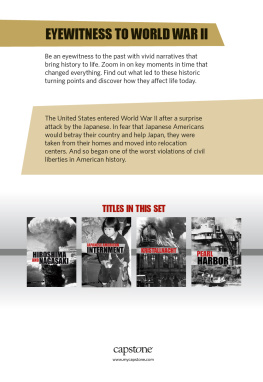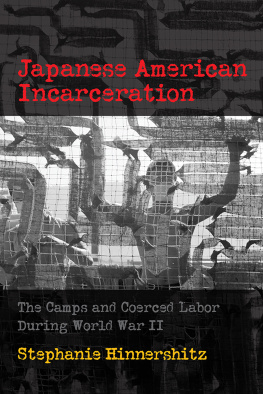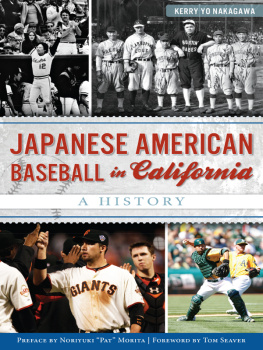
The George and Sakaye Aratani Nikkei in the Americas Series
Series editor Lane Hirabayashi
This series endeavors to capture the best scholarship available illustrating the evolving nature of contemporary Japanese American culture and community. By stretching the boundaries of the field to the limit (whether at a substantive, theoretical, or comparative level) these books aspire to influence future scholarship in this area specifically, and Asian American Studies, more generally.
Barbed Voices: Oral History, Resistance, and the World War II Japanese American Social Disaster, A RTHUR A . H ANSEN
Distant Islands: The Japanese American Community in New York City, 18761930s, D ANIEL H . I NOUYE
The House on Lemon Street, M ARK H OWLAND R AWITSCH
Relocating Authority: Japanese Americans Writing to Redress Mass Incarceration, M IRA S HIMABUKURO
Starting from Loomis and Other Stories, H IROSHI K ASHIWAGI, EDITED AND WITH AN INTRODUCTION BY T IM Y AMAMURA
Taken from the Paradise Isle: The Hoshida Family Story, EDITED BY H EIDI K IM AND WITH A FOREWORD BY F RANKLIN O DO
Barbed Voices
Oral History, Resistance, and the World War II Japanese American Social Disaster
Arthur A. Hansen
University Press of Colorado
Louisville
2018 by University Press of Colorado
Published by University Press of Colorado
245 Century Circle, Suite 202
Louisville, Colorado 80027
All rights reserved

The University Press of Colorado is a proud member of the Association of University Presses.
The University Press of Colorado is a cooperative publishing enterprise supported, in part, by Adams State University, Colorado State University, Fort Lewis College, Metropolitan State University of Denver, Regis University, University of Colorado, University of Northern Colorado, Utah State University, and Western State Colorado University.
ISBN: 978-1-60732-811-7 (cloth)
ISBN: 978-1-60732-812-4 (ebook)
DOI: https://doi.org/10.5876/9781607328124
Library of Congress Cataloging-in-Publication Data
Names: Hansen, Arthur A., author.
Title: Barbed voices : oral history, resistance, and the World War II Japanese American social disaster / Arthur A. Hansen.
Other titles: George and Sakaye Aratani Nikkei in the Americas series.
Description: Louisville : University Press of Colorado, [2018] | Series: George and Sakaye Aratani Nikkei in the Americas series | Includes bibliographical references and index.
Identifiers: LCCN 2018023680| ISBN 9781607328117 (cloth) | ISBN 9781607328124 (ebook)
Subjects: LCSH: Japanese AmericansEvacuation and relocation, 1942-1945. | Japanese AmericansSocial conditionsHistory20th century. | World War, 1939-1945Concentration campsWest (U.S.) | Civil disobedienceUnited StatesHistory20th century. | World War, 1939-1945Japanese Americans. | Oral history.
Classification: LCC D769.8.A6 H356 2018 | DDC 940.53/1773089956dc23
LC record available at https://lccn.loc.gov/2018023680
This publication was made possible with the support of Naomi, Kathleen, Ken, and Paul Harada, who donated funds in memory of their father, Harold Shigetaka Harada, honoring his quest for justice and civil rights. Additional support for this publication was also provided, in part, by UCLAs Aratani Endowed Chair, as well as Wallace T. Kido, Joel B. Klein, Elizabeth A. Uno, and Rosalind K. Uno.
is from Nikkei in the Pacific Northwest: Japanese Americans and Japanese Canadians in the Twentieth Century edited by Louis Fiset and Gail M. Nomura ( 2005) and reprinted with permission of the University of Washington Press.
For three special Nikkei friends: Kinji Yada, Lloyd Inui, and Kurtis Nakagawa
There is a crack in everything, thats how the light gets in.
Leonard Cohen
Contents
), respectively, the transfer of selected endnote content to the text proper and the inclusion of three appendixes. In addition, two overarching alterations have been effected: (1) the vocabulary utilized in relation to the World War II exclusion and detention experience of Japanese Americans has been rendered to reflect the recent terminological shift in the field of Japanese American studies from euphemistic to accurate descriptive language; and (2) all matters of editorial style have been placed in conformity with the guidelines set forth in the 16th edition of The Chicago Manual of Style.
Readers of this volume should also be aware of a few unavoidable inconsistencies within the text and the notes owing to historical peculiarities and changes in institutional nomenclature and classification. With respect to the first category, the detention center at Manzanar utilized idiosyncratic designations for its iterations as both an assembly center (Owens Valley Reception Center) and a relocation center (Manzanar War Relocation Center), while the detention center at Tule Lake was transformed in 1943 from the Tule Lake Relocation Center to the Tule Lake Segregation Center. As to the second category, in 2003 the Oral History Program at California State University, Fullerton, first altered its appellation in 2003 to the Center for Oral and Public History and then again in 2017 to the Lawrence de Graaf Center for Oral and Public History. At the same time, this institutions Japanese American Project, while officially retaining this name, sometimes chose to represent itself as the Japanese American Oral History Project so as to avoid having its title abbreviated with a racist acronym. Then, too, the University of California, Berkeleysponsored research group that was launched in 1942 under the name of the Evacuation and Resettlement Study (ERS) underwent an evolution in designation to the Japanese Evacuation and Resettlement Study (JERS) and then to the Japanese American Evacuation and Resettlement Study (JERS). In this connection, the collection of documents for this research group housed at UC Berkeleys Bancroft Library was first cataloged in 1958 under the label of the Japanese American Evacuation and Resettlement (JAER) and then re-cataloged in 1996 as the Japanese American Evacuation and Resettlement Records (JAERR). Accordingly, those chapters in this book that were originally published prior to 1996 have been referenced in conformity with JAER categories, while those published after 1996 have been referenced in conformity with JAERR categories.
Lane Ryo Hirabayashi
of this book. Strikingly, Uenos revelations ultimately tell us more about the power of oral history in the hands of an expert practitioner than they do about criminal responsibility.
Barbed Voices presents eight of Hansens best essays, but this book is much more than a convenient collection of article-length publications. Each chapter retains the extensive footnotes that mark Hansens reputation for meticulous detail, but each essay is now accompanied by a new prefatory introduction. By appearing for the first time in this fashion, within the new overarching analysis of the incarceration as a social disaster, this revitalized collection allows readers to appreciate more fully the integrity that has characterized Hansens research over the course of his long career.







 The University Press of Colorado is a proud member of the Association of University Presses.
The University Press of Colorado is a proud member of the Association of University Presses.